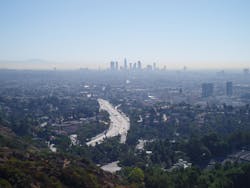Scientists Assess 100 Years of Los Angeles Groundwater Replenishment
The U.S. Geological Survey (USGS), in cooperation with the Water Replenishment District of Southern California (WRD), conducted a new study that analyzes how Los Angeles-area groundwater supplies are replenished. The analyses provide water managers with a clearer understanding of the sources and amount of available groundwater in the region—information that is important for planning and management of the vital resource.
Scientists used a new computer model to simulate rainfall and runoff in the greater Los Angeles-area and surrounding watersheds. They found that the average groundwater replenishment rate in the greater Los Angeles area from 1915 to 2014 was approximately 69,000 acre-ft per year, but varied with precipitation from less than 20,000 acre-ft in drier years to more than 200,000 acre-ft in wetter years. (An acre-ft is the amount of water required to cover an acre of land in 1 ft of water.)
More recent groundwater replenishment from 1971 to 2014 was 70,000 acre-ft per year on average. An average California household uses between 0.5 and 1.0 acre-ft of water per year.
“The findings from this study are very exciting and provide detailed information on anticipated recharge amounts from rainfall events in our service area,” said Ted Johnson, chief hydrogeologist at WRD. “A surprising finding was how much year-to-year variability there was on groundwater recharge amounts depending on the magnitude and distribution of daily precipitation compared to previous estimates.”
Scientists have long studied groundwater replenishment in the area, but the new study and associated computer model provide a broader and more detailed understanding of the overall groundwater system at a time when continuing drought conditions have intensified already complex water management challenges. The computer model used for the study simulates how and where water goes into and out of the aquifer system and includes factors affecting groundwater replenishment, such as precipitation, urban irrigation, climate variability, and varying land, soil and geologic characteristics of the region.
Unlike previous methods, which were used to estimate groundwater replenishment in the region, the new model incorporates more detailed data collected on a day-to-day basis. The model combines these daily data points with comprehensive maps of land use, land cover, soils, vegetation and surface geology to represent the physical characteristics of the greater Los Angeles region. This allows for a more complete account of the amount of water infiltration into the aquifers, evapotranspiration, and surface runoff resulting from precipitation and irrigation.
“This rainfall-runoff model takes into account the effects of recharge from surrounding mountains as well as individual storm events and climate variability on the water budget,” said Joseph Hevesi, USGS hydrologist and lead scientist on the project. “The model also offers a foundation for continued studies on the effects of water use and climate variability in the region.”
USGS and WRD have collaborated for more than 20 years to improve the scientific understanding and sustainable management of Los Angeles groundwater through data collection, geohydrologic research, and the development and application of regional groundwater flow models. The USGS recently assisted WRD with the installation of new deep-nested monitoring wells at an advanced water treatment facility under construction in the city of Pico Rivera. The facility is part of WRD’s Groundwater Reliability Improvement Project and will provide an additional 10,000 acre-ft per year of recycled water that will be used to replenish groundwater supplies.
The study, “Estimating Spatially and Temporally Varying Runoff and Recharge from Rainfall and Urban Irrigation in the Los Angeles Basin, California,” is available online. To learn more about USGS Water Science, please visit the USGS Water Resources of the United States website or the USGS California Water Science Center website.
Source: U.S. Geological Survey
